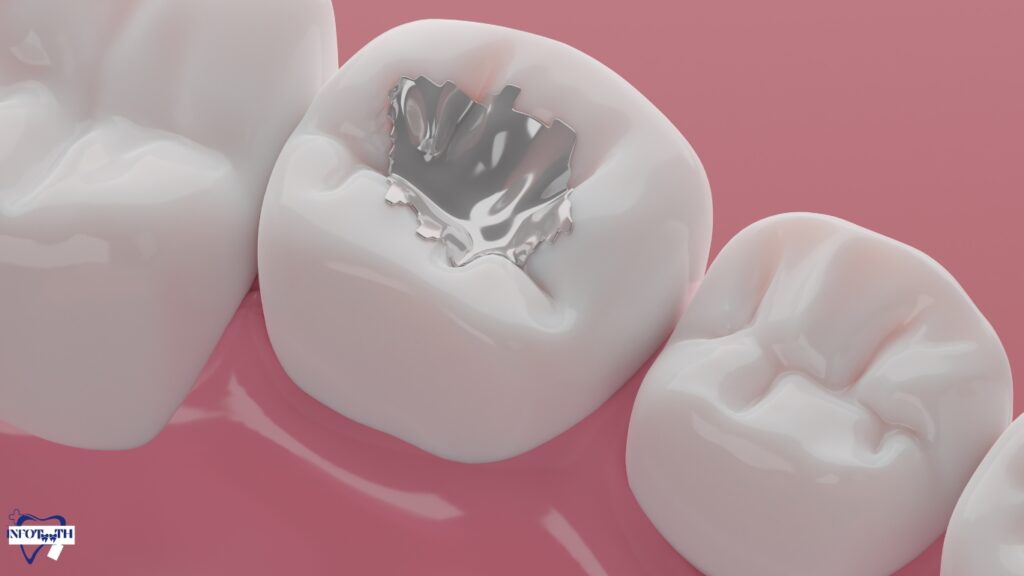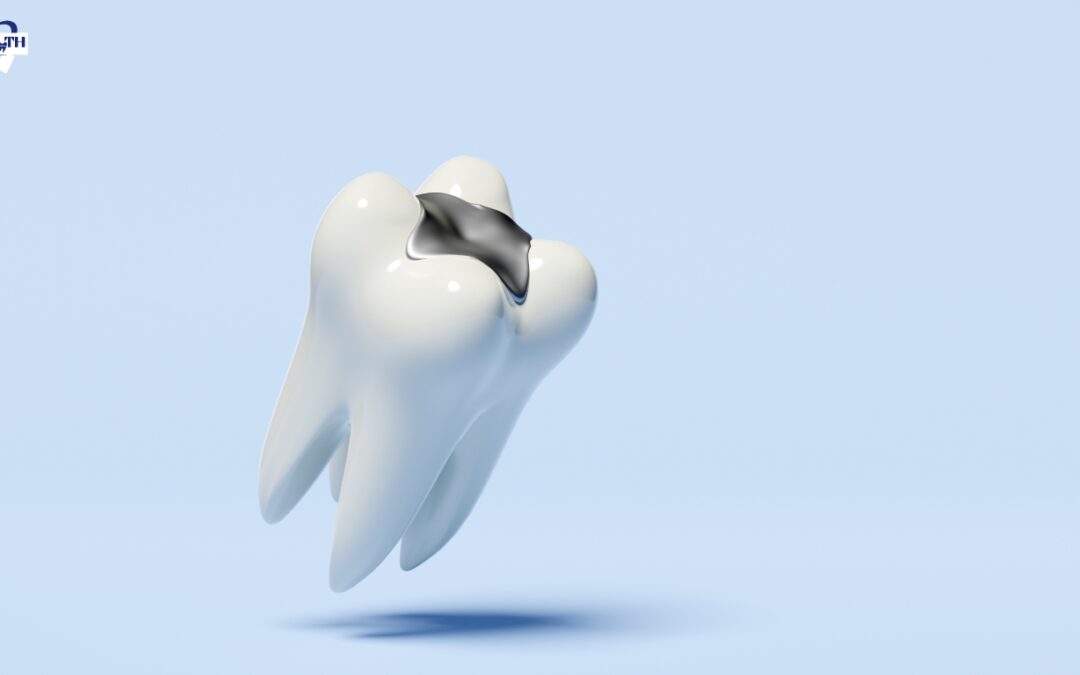Read this blog post to learn the ins and outs of black filling for teeth. For more than a century, dental amalgam, also known as “black filling for teeth,” has been a reliable option for tooth restoration. Examine the materials, longevity, and safety issues related to these fillings. We’ll examine frequent misunderstandings and available alternatives to help you make well-informed choices regarding the state of your teeth.
Table of Contents
Learn the truth about black fillings and how they function in contemporary dentistry.
What are the Causes For Black Filling For Teeth?
Dental amalgam fillings are commonly referred to as “black filling for teeth” since they are a popular option for repairing teeth that have become decaying or damaged. The amalgam mixture’s silver content is the main cause of these black filling for teeth. A mixture of metals, including silver, tin, copper, and mercury, make up dental amalgam. The filler substance has a pronounced black color due to the presence of silver.
The lifespan and durability of black fillings are some of the primary reasons why people choose them. Because dental amalgam can resist deterioration over time and can withstand the forces of chewing, it has been a dependable option for more than a century. This makes it a good choice for tooth restoration in parts of the mouth where biting and chewing apply a lot of strain.

The affordability of dental amalgam is an additional contributing factor. In contrast to alternative filling materials like porcelain or tooth-colored composites, amalgam fillings are frequently less expensive. This financial factor may be especially important for people without dental insurance or those looking for an affordable cavity treatment option.
What Is The Procedure For Black Filling For Teeth?
Dentists use dental amalgam fillings, also referred to as black filling for teeth, as a simple, tried-and-true method of restoring teeth that have had damage or decay. In order to guarantee the patient’s comfort during the process, the dentist first numbs the area around the damaged tooth with a local anesthetic.
After administering numbness, the dentist removes the damaged or decayed tooth tissue with a drill or laser, leaving a clean, ready-made space for the filling. After that, the dentist carefully shapes the dental amalgam mixture to fit the tooth’s natural contours by placing it inside the prepared space. The black filling for teeth provides strength and longevity by forming a strong bond with the tooth.

The dentist polishes and modifies the filling after it has been inserted to guarantee a good bite and a smooth surface that feels comfortable in the mouth. Numerous patients find it to be a handy alternative because the full procedure usually only requires one dental appointment.
Even though dental amalgam has proven to be a dependable option for dental restorations, patients must communicate any worries or preferences to their dentist. For those who value looks over functionality, there are alternative tooth-colored filling materials like porcelain or composite resin that can be used instead of the black look that comes with typical amalgam fillings.
Why Tooth Filling Turned Black And Hurts?
When a dental filling becomes painful and turns black, there are a few possible problems that may need to be addressed by a dentist. Dental amalgam, also known as a “silver filling,” is the most prevalent filling type linked to discoloration. These fillings may tarnish and darken over time for a number of reasons, such as tobacco use, exposure to specific foods and drinks, and so forth.
A filling that is painful and discolored could be a sign of several potential issues. Deterioration surrounding the filling is one typical issue. Bacteria may seep into the filling if there is a leak or a space between it and the tooth, which could result in decay underneath the filling. This may result in uncomfortable and sensitive teeth.
The filler material itself breaking down or deteriorating is another possible problem. Although amalgam fillings are strong, their lifespan is limited. They could deteriorate, crack, or shatter over time, letting germs in and jeopardizing the structural integrity of the tooth. Pain and suffering may follow, indicating a need for immediate dental care.
In certain instances, alterations in the pulp tissue or nerve of the tooth may be the cause of the discomfort accompanied by a darkened filling. Increased sensitivity and pain may result from inflammation and infection brought on by decay that has spread to the tooth’s inner layers.
Can Black Fillings Be Changed To White?
Of course! You have options if you’re thinking about replacing your dental amalgam often known as black filling for teeth in your teeth with white fillings for a more aesthetically attractive appearance. Because black filling for teeth are strong and long-lasting, they have been a conventional option. However, because amalgam fillings are prominent because of their metallic color, many people look for alternatives for aesthetic reasons. Composite fillings, sometimes referred to as white fillings, are a common substitute that can mimic the natural color of your teeth.

In order to convert black filling for teeth to white, the amalgam fillings must normally be removed and replaced with composite resin fillings. The tooth-colored material used in composite fillings is typically a blend of glass and plastic particles. This gives them a more understated and beautiful appearance by enabling them to blend in perfectly with your natural teeth. Sometimes black teeth causes missing teeth.
Even while aesthetic factors may drive the choice to replace fillings, it’s important to speak with your dentist to assess the procedure’s viability and the general condition of your teeth. They can talk about the advantages and possible drawbacks of the replacement procedure, making sure that switching from black to white fillings produces an enhanced aesthetic and maintains tooth health.
What are Black Fillings Made Of?
Dental amalgams, or black filling for teeth, are composed of a combination of metals, including copper, zinc, tin, and mercury. Because of its strength and longevity, this alloy has been used extensively in dentistry for more than a century. The silver content of black filling for teeth is mainly responsible for their dark color. Although it works well, there has been some debate concerning the mercury content, which has led to worries about possible health hazards.
It’s crucial to remember that dental amalgam contains stable mercury that has been approved for use by numerous dental societies. The substance is prized for its durability and strength in the face of chewing pressure. Black filling for teeth is still a commonly used and approved method of tooth restoration, even if there are more cosmetically acceptable options available, such as tooth-colored composite resin fillings. When thinking about getting dental fillings, people should speak with their dentist so they may make an informed decision based on their own needs and preferences for oral health.
How To Get Rid Of Black Fillings For Teeth?
Composite resin is a popular substitute for black filling for teeth in dentistry. With a more realistic appearance, this tooth-colored substance is composed of a blend of plastic and glass particles. By bonding directly to the tooth, composite resin fillings enable more of the original tooth structure to be preserved through conservative restoration methods. They are also adaptable and suitable for small to medium-sized cavities.
Ceramic or porcelain fillings are an additional choice. Because of their strength and stain resistance, these materials offer a natural appearance that closely resembles the color of your teeth. Custom-made in a dental laboratory, porcelain fillings provide exceptional aesthetics together with a precise fit.

It’s important to share your preferences and worries with your dentist, who can assess your dental health and make recommendations based on your requirements. Remember that your budget, any potential allergies or sensitivities, the cavity’s size and location, and other factors may all play a role in the filling material decision.
Although dental amalgam has been extensively utilized and accepted as safe, people can now select restorations that are both practical and aesthetically pleasing by selecting tooth-colored alternatives.
Conclusion
In conclusion, dental amalgam, a dependable and established option for tooth restoration, is commonly referred to as black filling for teeth. Dental amalgam is made of silver, tin, copper, and mercury. Because of its black appearance, some people may be concerned about cosmetics and look for tooth-colored alternatives. Even though dental amalgam is generally regarded as safe, talking to a dentist about filling options can assist in addressing personal health concerns and cosmetic preferences for a more customized approach to tooth care.
FAQs
Q: Are my amalgam (black filling for teeth) safe to have in my teeth?
A: Dental groups widely accept dental amalgam, also known as “black filling for teeth,” as safe. The materials are stable and have been shown in multiple investigations to be safe, even with mercury bonded in them. However, it’s crucial to talk to your dentist about any worries you may have.
Q: Are there additional natural-looking filler options available except black ones?
A: Yes, fillings made of tooth-colored materials, such as porcelain or composite resin, can look more natural. For those who would rather have a less obvious dental restoration, these options might be appropriate.
Q: For what duration do black filling for teeth usually last?
A: Dental amalgam fillings are renowned for being long-lasting and resilient. They can typically last 10 to 15 years or even longer with consistent dental checkups and good oral hygiene. Individual experiences, however, could differ.
Q: Is it possible to remove black filling for teeth and get tooth-colored fillings in their place?
A: Yes, if preferred, tooth-colored fillings can be used in place of black ones. But, the choice to take out and replace fillings should only be made after talking with your dentist about your individual dental needs.
Q: Are there any health risks associated with the mercury concentration of black filling for teeth?
A: According to scientific studies, dental amalgam’s mercury is bound in a way that renders it safe for use in dental fillings. Amalgam fillings are typically thought to expose people to very low quantities of mercury, well within permissible bounds.

